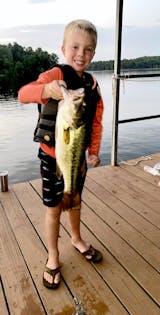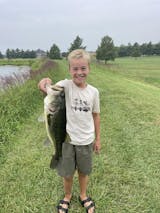
Soft Plastic Worms & Stickbaits 101
By Discount Tackle Staff
One of the easiest and most widely-used baits among bass anglers is the soft plastic worm (aka stickbait or stickworm). When using worms, there are many subtle differences in technique, but, even still, they are far less complicated than many other baits, while being just as effective. This makes soft plastic worms an excellent bait for both novice and advanced bass anglers and everyone in between.
Stickbait Worms (aka Stickworms)
The Gary Yamamoto Senko and similar copy-cat Senko-style baits are the most common type of stickbait style worm. They are very simple, and anyone can use them. You can take a 5 inch Senko and stick the hook right in the middle, wacky-style, or Texas rig it, where the hook goes in through the front of the bait, then back outward, and then the point of the hook comes back and sticks into the body of the worm, hiding the point. If you are fishing calm, shallow water, there is no need for weights, but they may be desirable in choppier, deeper water or when you need extra weight to punch through vegetative cover. When you cast it, it will slowly sink to the bottom with a signature side-to-side, shimmy-like motion, like a feather or a leaf that is floating to the ground. Fishing the bait unweighted allows you to make the most of this natural falling action, so it's generally preferable to rig weightless if you want the bait to exhibit a lot of movement as it sinks.
There's no need for a lot of work on your end. Cast the bait out there and let it sink on its own until it reaches the bottom. Occasionally you can jerk the line very gently and sparsely, but, for the most part, all you have to do is let it sink. When it lands on the bottom, you can pull it up slightly and let it fall right back down, very subtly. The most hits will come as the bait is falling. The slight jerk of the line might catch the fish's eye, but, when it continues to fall, that's when they'll strike it. Most of the time, extra movement on your part isn't even necessary. This technique is simple, and it works anywhere in the country.
Ned Rig Worms & Stickbaits
Another bait that has been rising in popularity in recent years, particularly in the Mid-West, is the Ned rig. Ned rigs consist of smaller plastic baits, like worms, craws, or other creatures, with a light mushroom-shaped head that helps it float to the bottom. Many people move this bait aggressively, hopping it and letting it move around, because it looks good to us under the water. But letting this bait still perfectly still, or barely moving at all, is often much more effective. Fish are more likely to attack on their own, just as the bait pauses. Crankbaits, and other fast-moving baits, that you'd think require an aggressive presentation, often prompt a strike as they are resting. Even if there had been more vibrant or spastic movements moments earlier, as the bait stops moving, the fish strike.
Straight Tail Worms
The next bait might be a little confusing, because it's called the “shaky head.” You certainly can shake it, but shaky head baits are a little more effective when you drag them and then let them sit. The pauses are important. If you do have more of a shaky approach, don't forget the pauses, because that is when the fish strike. Moving your bait too aggressively can seem unnatural and different from how the bass's prey might behave. Just drag it patiently, and the fish will come over and investigate. Pause, and, as the bait starts to move again, they will hit.
A very important method, and the easiest way for the typical angler to catch a large number of fish, is the drop shot. The drop shot configuration has a weight on the very end, but the hook and plastic worm are about eight inches to a foot higher up on the line. The weight rests on the bottom, and the worm floats above it. As the worm is suspended, you can gently shake it –not so hard that it's unrealistic, but gently. You can shake it up slightly and let if fall, or just give it gentle tugs, hopping it along the bottom. The fish will attack as the bait is falling. Using a very light hook will slow the descent of the bait to the bottom, and prolong the time where the bait is attractive to the fish. Using this method can be very effective in drawing the fish in, but you must be careful, because if you're too forceful reeling the fish in, you can bend the hook out.
One of the reasons plastic worms are so great is that the techniques you use don't require years of practice. They are simple compared to other baits, and beginning fishermen can quickly pick them up and start using them effectively. In most cases, you just throw them in, and the worm does the majority of the work. Even in conditions were there is a lot of grass and water plants, the worm will rest on top of the plants, where fish are naturally hunting crayfish, bugs, and other creatures. You don't have to worry about weights, or how the hook is rigged. Fish will come up and eat it as it's resting on top of the plant life.
The most important things to remember, when fishing plastic worms is to fish more slowly. Be patient, and let the worm do most of the work. Taking advantage of pauses in retrieve as well as the natural Pauses are extremely important. You certainly can add your own movement, but the resting phase is when the fish bite.
Rods & Reels for Soft Plastic Worms & Stickbaits
Another great thing about fishing soft worms is that they don't require specialized or difficult to use rods and reels. All three of the soft plastic worm and stickbait sub-categories we discussed above can be thrown with a 1000 to 2500 size spinning reel and a 6 foot 8 inch to a 7 foot 6 inch, Medium power/Fast action spinning rod.
An entry level spinning reel like Daiwa Revros LT or Legalis LT paired with a Dobyns Fury or 13 Fishing Omen Black 3 spinning rod is an excellent all around set-up for fishing soft plastic worms.



